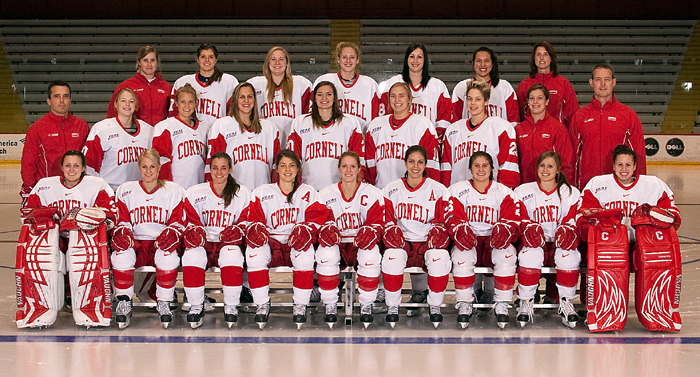by Timothy Weisberg | Feb 1, 2011 | Blog
They are called the Lynah Faithful. Hundreds of students gather outside, often waiting for hours to purchase Red men’s hockey season tickets. Men’s hockey is a cultural phenomenon at Cornell, and Lynah Rink stands as a microcosm for a mutual identity among college students; a sense of pride and unity among the other 13,000 undergrads that coincide with one another in this small, yet unique Central New York town.
But what a lot of people don’t know is that people are paying over $200 on season tickets to watch a team that is currently 9-9-3, and are currently fifth in the Eastern College Athletic Conference (ECAC), while the women’s team is currently ranked No. 2 in the nation with a astonishing 22-1 record, and have yet to lose in conference play (16-0).
What is even more remarkable is the sheer dominance the forgotten Red smother on their opponents. They have only given up two or more goals twice all season, and have boasted 13 shutouts.
They are currently on an 18-game winning streak and have not lost since Nov. 2. Can you even list the men’s 9 losses?
4,200 pack Lynah Rink to see a men’s team that quite frankly, is having an off year–yet you will be lucky to see 400 spectators at women’s hockey games, where a dynasty is in the making.
The Red embarked on an even more unprecedented run than the Red’s Sweet 16 basketball team, making it all the way to the NCAA Title Game, before losing a heartbreaker to the University of Minnesota-Duluth 3-2 in triple overtime.
While the men’s basketball team winning not only their first-ever NCAA Tournament game, but also making a Sweet 16 experience was remarkable, even our own President picked them to be in the Sweet 16 (as did I).
I’ll put $100 on it that you could ask 10 Cornellians if they knew the women’s hockey team made it to the title game last season, they would not have the slightest idea.
But that’s the reality of women’s collegiate athletics. Title IX may be implemented to provide women an equal opportunity in collegiate athletics, but it does not make students compelled to watch women compete.
I am not a saint either, preferring to watch men’s collegiate athletics, but you would think hockey would be the lone exception to a very sexist and arbitrary rule–men are more entertaining to watch compete than women.
While women are entitled to the same opportunity to compete on college’s biggest stage, you can’t help but think that men and women are separate, but “equal” entities.
Women may use the same facilities, be provided the same funding and same opportunities, but they continue to be shadowed and segregated from the popularity of men’s collegiate sports.
This is simply a bitter reminder when it took the University of Connecticut women’s basketball team 89 straight wins to finally be recognized by major media outlets such as ESPN.
They can talk about the University of Syracuse struggling, or Michigan State falling out of the top 25, but 89 straight wins is what it takes, an utter dynasty in the making to make media outlets obligated to provide extensive coverage.
People argue women’s sports have less parity than men’s sports, making it easier for dynasty-esque teams to sprout up, but hockey is one sport where it is extremely hard to stay consistent and dominate the opposition like the Red have done this season.
Ever heard of a hockey team winning 18 straight games? I hadn’t either. I also haven’t heard of a hockey team outscoring its opponents 113-17. That’s less than one goal allowed per game.
So may we attempt to pay homage to the forgotten counterparts at Lynah Rink, where the concept of equal might be equal, but the question begs whether or not it is fair?
Equal in opportunity (thank you Title IX!), but unequal in expected outcome.
by Timothy Weisberg | Jan 8, 2011 | Blog
As we file our New Year’s Resolutions, reflect upon the new year, and soak in the idea that the year is now 2011, an incredible decade of college football is behind us. We saw the emergence of the non-BCS schools searching for a way to convince the big boys they are worthy to play with the “men” of the BCS schools, a couple of fantastic and surprising finishes to college football’s biggest stage, the BCS National Championship, but above all, games that will be remembered for the years to come. So I cordially bring to you my top 10 greatest college football games of the past decade, as we journey through the thrill of victory and the agony of defeat. Feel free to leave a comment suggesting a game that you may have thought should have made the list. This wasn’t easy folks. Enjoy, and may you reminisce the days sitting in front of your flatscreen, eating chips and salsa slouched on your couch rooting on your hometown team, the underdog, or witnessing the unthinkable happen. Because college football is where the absolutely sensational, most incredible things happen (take that NBA where only “amazing” happens!). Enjoy!
Honorable mentions:
Northwestern v. Minnesota: Oct. 28, 2000 (Northwestern 41, Minnesota 35)
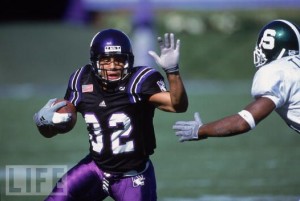
Google Images
In the height of the Randy Walker era, Northwestern implemented the very exciting “no huddle,” spread offense to put together one of the most prolific offenses in the entire Division I (now known as FBS) in 2000. They finished with an 8-4 record, but not after some incredible comeback wins and exciting finishes to their season. Featuring quarterback Zak Kustok, receiver Sam Simmons and running back Damian Anderson, the Wildcats were a team to be reckoned with in the powerful Big Ten. This particular comeback and incredible finish happened to be in the HHH Metrodome against the University of Minnesota.
Infamously known as “Victory Right,” Zak Kustok completed a 45-yard Hail Mary pass to receiver Sam Simmons as time expired to give the Wildcats the shocking victory, 41-35. The Wildcats had rallied from a 35-14 deficit to comeback and stun the Golden Gophers.
The Golden Gophers head coach at the time Glen Mason famously had this to say after the game: “You feel like your guts are ripped out…” Talk about a gut-wrencher.
Video: “Victory Right”
#10 Texas Tech v. #2 Texas: Oct. 22, 2008 (Texas Tech 39, Texas 33)
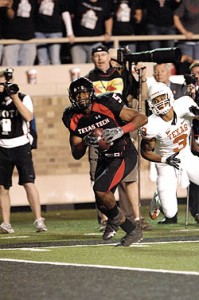
Google Images
This Big 12 match-up featured two top-ten teams in the Red Raiders (No. 6) and the No. 1-ranked Texas Longhorns led by current NFL quarterback Colt McCoy. The Red Raiders made a surprise run under head coach Mike Leach and his run n’ gun offense, and All-American receiver Michael Crabtree. The game went down to the wire with the Red Raiders trailing 33-32 with eight seconds left.
Red Raiders quarterback Graham Harrell threw a ball downfield to Crabtree, who caught the ball near the sideline at the 6-yard line, broke a tackle, and went in for the go-ahead score with one second left. The Red Raiders held on for the upset, dethroning then-No. 1 Texas in a 39-33 thriller.
Video: Crabtree game-winning TD
10. Jacksonville State v. Ole Miss: Sept. 4, 2010 (Jacksonville State 49, Ole Miss 48 2OT)
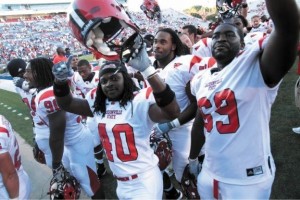
Google Images
A year after coming off a 9-4 season, which included a 21-7 win in the Cotton Bowl, the Ole Miss Rebels were vying for another strong season under third-year coach Houston Nutt. After offensive coordinator Kent Austin left for the head coaching job at Cornell University, the Rebels were under a new offensive scheme, and made headlines when former Oregon quarterback Jeremiah Masoli walked on to the team months before, after being dismissed from the Ducks. Masoli was cleared to play just a day before the Rebels’ opener against Jacksonville State. Boy was Masoli and crew in for a treat.
The Rebels led 31-10 at halftime, but the Gamecocks from the FCS outscored the Rebels 24-3 in the second half to send the game into overtime. The Gamecocks had tied the game on a tocuhdown and successful two-point conversion with eight seconds left in regulation.
In the second overtime with the Rebels up 48-41, Gamecocks quarterback Coty Blanchard threw a 30-yard touchdown pass on fourth-and-15 to Kevyn Cooper. And what did the Gamecocks from Jacksonville, Ala. decide to do? Go for the win. To cap off as the FCS spoiler, the Gamecocks completed the improbable comeback and stunned the Oxford faithful when Blanchard found running back Calvin Middleton. Jacksonville State 49, Ole Miss 48. The Ducks are 12-0 and headed to the BCS title game in Glendale while the Rebels finished the year 4-8 and 1-7 in the SEC. Bet Masoli is reconsidering his decision now more than ever, if not already after an embarrassing loss to an FCS team at home.
Video: Jacksonville State upsets Ole Miss
9. Marshall v. East Carolina in the GMAC Bowl: Dec. 19, 2001 (Marshall 64, East Carolina 61 2OT)
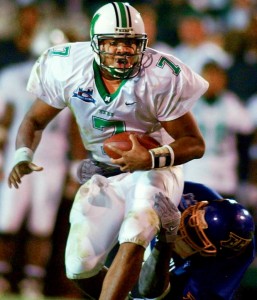
Google Images
The Marshall Thundering Herd experienced unprecedented success during the early 2000s and their match-up with East Carolina in the 2001 GMAC was one for the books.
The Thundering Herd were the Mid-American Conference East Champions, and were 10-1 heading into the MAC championship, only to be upset by Toledo.
So then there was the GMAC Bowl, where the teams combined for a bowl record 125 points and featured high-octane offenses from future NFL quarterbacks and teammates Byron Leftwich (Marshall) and David Garrard (East Carolina).
The game was a back-and-forth affair, but was at first a blowout with the Pirates leading 38-8 at halftime. But the Herd stormed back under the leadership of Leftwich. With 1 minute and 53 seconds left, Marshall kicked a field goal to cut the Pirates lead to 6 at 51-45. The Herd went for an onside kick and did not recover, but forced the Pirates to go three and out, forcing them to punt.
With 50 seconds left and no timeouts, Leftwich led a furious drive, which finished with a touchdown pass to Darius Watts with seven seconds left. All the Herd needed was an extra point to take the lead and ultimately seal the victory, but for the seventh time that season, kicker Curtis Head missed an extra point, leaving the game tied at 51 to end regulation and forcing overtime.
Both teams scored touchdowns in the first overtime session. In the second overtime, the Pirates made a field goal to take a 61-58 lead. At the eight-yard line and on third and goal, the Herd finally put the game to rest when Leftwich connected with Josh Davis to give the Herd a 64-61 victory.
Statline: 16 combined touchdowns, 576 passing yards by Leftwich, highest scoring bowl game ever.
Video: Marshall Thundering Herd touchdown drive
8. UCLA v. #2 USC: Dec. 2, 2006 (UCLA 13, USC 9)
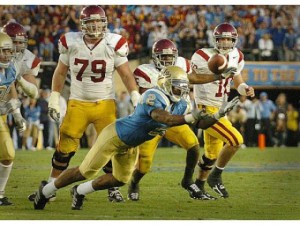
Google Images
The USC Trojans came into the game needing a win over 6-5 UCLA to earn a trip to the BCS National Title game. Too bad for the Trojans, that’s why they have rivalry games. The Bruins were up 13-9 with the Trojans driving down the field. With under two minutes left, Trojan quarterback John David Booty threw a pass that was tipped up in the air and then miraculously caught by Bruins linebacker Eric McNeil. The interception gave the Bruins the ball back with 1:10 remaining and pulled off the stunning upset.
Instead of the Trojans, Tim Tebow’s Florida Gators snuck into the BCS title picture and ended up defeating the Ohio State Buckeyes while USC had to tread back to the Rose Bowl for a New Year’s Day game. Respectable, but not what the Trojans had in mind. The loss snapped a 9-game losing streak by the Bruins in the Battle for the Gauntlet, and snapped an NCAA-record 63 consecutive 20-point games held by the Trojans.
Video: UCLA’s Eric McNeal INT
7. #23 Northwestern v. #12 Michigan: Nov. 4, 2000 (Northwestern 54, Michigan 51)
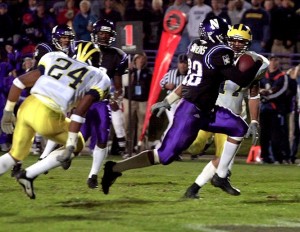
Google Images
This Big 10 showdown featured two 6-2 teams ranked in the top 25 in the Northwestern Wildcats and the Michigan Wolverines. The Wildcats had come off a miracle win in Minnesota the previous week (see Honorable mention game and “Victory Right”), and were the clear underdogs when they hosted Michigan.
It was a back-and-forth battle (combined to score 105 points). Michigan was ahead 51-46 with under two minutes left. It was fourth and goal from the Michigan 12 when Kustok threw a ball to a wide open Sam Simmons, who caught the game winning Hail Mary the previous week, only to see him drop a wide open pass in the end zone, giving Michigan the ball back with 1:38 remaining.
All Michigan needed to do was run out the clock. Unfortunately, running back Anthony Thomas mishandled the ball and fumbled, giving the Wildcats new life with 46 seconds left.
Kustok found Simmons again for an 11-yard touchdown with 20 seconds to go. This time he caught it and Northwestern led 54-51.
Michigan had a chance to send the game to overtime with a 57-yard field goal as time expired, but a botched snap on the hold completed the wild finish and another miracle win for the Wildcats in as many weeks.
Video: End of game from 4:57 on
6. #1 USC v. Notre Dame: Oct. 15, 2005 (USC 34, Notre Dame 31)
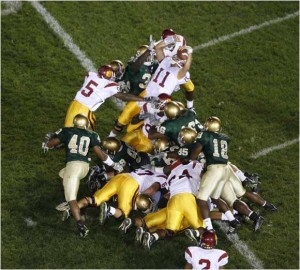
Google Images
No. 1 USC was put to the test against the Fighting Irish in a late non-conference rivalry game in South Bend, Ind. USC came into the game boasting a 27-game winning streak and were the defending national champions. Notre Dame, led by Brady Quinn, marched down the field trailing 28-24, and scored the go-ahead touchdown with just over two minutes remaining to give the Fighting Irish a 31-28 lead.
But USC put on an incredible final drive. With 1:32 remaining and on fourth-and-nine, the 27-game streak and number one ranking in serious jeopardy, Trojans quarterback Matt Leinart threw a fade route down the sideline to Dwayne Jarrett just over the outstretched arm of Irish cornerback Ambrose Woodson, and Jarrett scurried all the way down to the Irish 13-yard line.
Two rushes by Reggie Bush brought the Trojans to the Irish two-yard line. With seven seconds remaining and on third and goal, what became known famously as the “Bush Push,” the game ended when Bush pushed Leinart into the end zone for the game-winning touchdown with three seconds remaining to give USC the 34-31 victory.
The controversial push should have resulted in a five-yard penalty, but is often rarely called and even then Irish coach Charlie Weis expressed hope that his running back would do the same.
Either way, USC went on to finish undefeated during the regular season before losing in the BCS National Championship game 41-38 to Vince Young’s Texas Longhorns at the Rose Bowl.
Video: USC final drive
But the Trojans got the last laugh on June 10, 2010 when the NCAA declared Bush ineligible for the entire 2005 season, thus vacating the Trojans victory.
Although in the books the game never actually happened, it was a wild finish in a storied rivalry.
5. #4 Boise State v. #19 Nevada: Nov. 26, 2010 (Nevada 34, Boise State 31 OT)
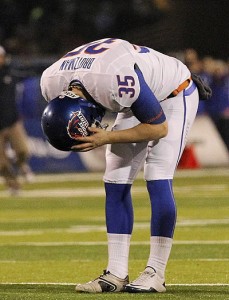
Google Images
Boise State was poised for a BCS berth and possibly becoming the first non-BCS team to play in a BCS national title game. All they had to do was finish off the University of Nevada on the road.
The Broncos looked poised for another undefeated season taking a 24-7 lead at halftime. But the Wolfpack stormed back, tying the game at 24 in the third quarter.
It was 31-24 Broncos when Wolfpack quarterback Colin Kaepernak hit receiver Rishard Matthews on a 7-yard pass to tie the game at 31 with 13 seconds left.
The game looked destined to be headed to overtime, but Broncos quarterback Kellen Moore hit receiver Titus Young for 53 yards on the first play from scrimmage, setting up the Broncos for a 26-yard chip shot.
The usually efficient Broncos kicker Kyle Brotzman hooked the kick right, sending the game into overtime and giving the Wolfpack another shot.
The Broncos had the ball to start the overtime period, and set up Brotzman for a chance to redeem himself. This time from 29 yards, Brotzman hooked the kick again, this time wide left, missing his second field goal of the game.
The Wolfpack took over and Wolfpack redshirt freshman kicker Anthony Martinez did not miss from 34 yards, giving the Wolfpack the improbable win over the Broncos 34-31 in overtime.
Not only was this an exciting game, but the implications of the outcome were astonishing. The Broncos crushed their chances of playing in a BCS bowl game, and allowed TCU to earn a Rose Bowl berth, who with a Broncos victory would have been almost certain to miss out on a BCS game despite an undefeated season.
A Wolfpack win did the following:
-Forced a three-way tie for the WAC championship with the Hawaii Warriors, Nevada Wolfpack and Boise State Broncos.
-Allowed TCU to jump to No. 3 in the polls and earn a Rose Bowl berth (which they won, setting up an even bigger stage for the non-automatic qualifying schools).
-Instead of a BCS Bowl berth landed Boise State MAACO Las Vegas Bowl.
-Biggest win in Nevada Wolfpack history, and first win against a top 10 team.
Kyle Brotzman’s kick turned out to be a true million dollar kick as the school lost sure millions in revenue by not making a BCS bowl game. A thriller to the max ultimately demonstrated how important a non-AQ was to the outcome of the BCS bowl picture.
Video: Nevada beats Boise State in OT
4. #1 Miami (FL) v. #2 Ohio State: 2003 Tostitos Fiesta Bowl (Ohio State 31, Miami (FL) 24 2OT)
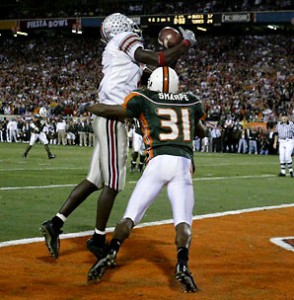
Google Images
The defending national champions took on an Ohio State team that featured star running back Maurice Clarett and a potent Buckeye offense. The University of Miami was shooting for back-to-back titles and attempted to extend their historic winning streak, which was at 34 games heading into the title game.
The Hurricanes roster included future NFL stars Willis McGahee, Ken Dorsey, Andre Johnson, Kellen Winslow, Jr., Antrel Williams and the late Sean Taylor. But the Hurricanes were put to the test against a talented Buckeye squad led by quarterback Craig Krenzel and receivers Chris Gamble and Michael Jenkins.
The game was down to the wire, with the Buckeyes up 17-14 late in the fourth quarter. After a controversial call that said Gamble caught a ball out of bounds (he was in fact in bounds and a Miami defender had been grabbing him by his jersey to take him down), the Buckeyes were forced to punt. If the call had stood, the Buckeyes could have ran out most of the clock.
So the Buckeyes had to punt to dangerous return man Roscoe Parrish. Parrish ran the ball back 50 yards down to the Buckeye 26-yard line with 2:02 remaining.
But the Hurricanes went three and out, and it was fourth and seven with seven seconds left. The Hurricanes elected to go for the game-tying 40-yard field goal.
Hurricanes kicker Todd Sievers converted on the kick with no time remaining to send the game into overtime tied at 17.
The teams exchanged touchdowns in the first overtime, sending it to a second overtime. But what turned out to be one of the most controversial calls of the decade occurred during the first overtime session as the Buckeyes attempted to tie the game to send it to a second session.
It was fourth and three at the five yard line. Krenzel attempted a pass to Gamble, but the ball bounced off Gamble’s hands and was ruled incomplete. The fans and team began to rush the field believing the game was over until the field judge threw out a late flag. The flag was defensive pass interference on Miami defender Glen Sharpe. The penalty gave the Buckeyes the ball at the two yard line and a first down, allowing them another chance to tie the game, which they did.
The Buckeyes got the ball first in the second overtime, and Clarett scored on a five-yard touchdown run to put the Buckeyes ahead 31-24.
The Hurricanes needed a touchdown to send the game to a third overtime, but Dorsey was rushed from the pocket on fourth and goal from the one and the pass fell incomplete, and the Buckeyes won 31-24, ending the Hurricanes 34 game winning streak.
Video: Pass interference? you be the judge
3. #1 USC v. #2 Texas: 2006 Rose Bowl BCS National Championship (Texas 41, USC 38)
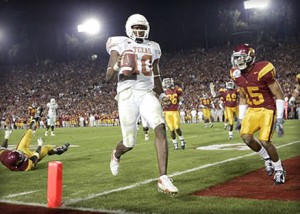
Google Images
The game featured the only two undefeated teams in Division I. The Trojans were looking to win back-to-back national championships, while Texas won the Rose Bowl the previous season.
The game featured future NFL quarterbacks Matt Leinart and Vince Young. Featuring the two top offenses in the country, it was a shootout from the beginning, and USC held a 38-33 lead late in the fourth quarter.
At Texas’ 45-yard line, then Trojans coach Pete Carroll elected to go for it on fourth and two, but running back Lendell White fumbled the football, and Texas recovered at their own 44-yard line with 2:09 to play in the game.
Young and the Longhorns marched down the field, but faced a fourth and five from the nine-yard line. Young’s receivers were covered and he bolted toward the right sidelined and beat Trojans freshman cornerback Kevin Thomas to the end zone (that’s a shout out to the Thomas brothers who I went to high school with. Sorry that it had to be when the Trojans lost, but Thomas was the closest defender to Young).
Young scored with nine seconds to play, capping one of the greatest Rose Bowl performances. The Longhorns converted the two-point conversion to make it 41-38, and eventually held on to win by that score, spoiling the Trojans’ run to back-to-back titles.
Video: Vince Young game-winning score
2. #9 Boise State v. #7 Oklahoma: 2007 Tostitos Fiesta Bowl
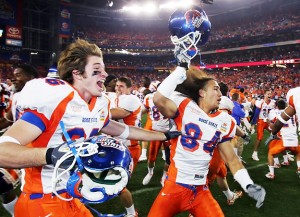
Google Images
This one was probably the hardest decision to make on my part, as I strongly considered it to be the greatest college football game of the decade, and arguably all-time. But as it stands, the Broncos from Boise come in at No. 2.
The Tostitos Fiesta Bowl featured non-BCS school Boise State, who rose through the ranks and were undefeated heading into the game, and Oklahoma. The Broncos were heavy underdogs and turned what was supposed to be a no-brainer for the Sooners into one of the greatest college football games of the decade.
Featuring two potent offenses, this one was a shootout and featured a wild finish. The Broncos were leading the Sooners 28-20 in the fourth quarter when the Sooners drove down the field and scored on a five yard touchdown pass from Sooners quarterback Paul Thompson. However, the Sooners needed the two-point conversion, and a 6-yard pass from Thompson to Juaquin Iglesias tied the game up at 28 with 1:26 remaining in the fourth.
The Sooners had trailed 28-10 midway through the third quarter and scored 18 straight to tie the game.
On the ensuing possession by the Broncos, quarterback Jared Zabransky was intercepted by Marcus Walker, who ran it back 34 yards for the touchdown, and the Sooners took a 35-28 lead with 1:02 left, its first lead of the game.
The Broncos got the ball back and drove it down to the Sooners 42-yard line, but were facing a fourth and 18 with only 18 seconds left. Zabransky passed for 15 yards to Drisan James, and James then passed the ball to a streaking Jared Rabb, who ran the ball down the sideline for 35 yards to score with seven seconds left.
The Broncos nailed the extra point and sent the game to overtime with the game tied at 35 at the end of regulation. The hook-and-lateral play was called “Circus” by the Broncos, with the lateral a pre-designed play.
The Sooners started with the ball in the first overtime session, scoring on an Adrian Peterson run on the first play from scrimmage.
The Broncos then needed a touchdown to send the game into a second overtime. Facing a fourth and two at the Sooners’ five-yard line. Zabransky ran in motion while backup wide receiver Vinny Peralta ranto the right and took the snap, rolling out and hitting tight end Derek Schouman for the touchdown score to make it 42-41.
Instead of kicking the extra-point, Broncos coach Chris Petersen went for the win, electing to go for the two-point conversion. Infamously known as the “Statue of Liberty” play, Zabransky faked a pass to his right and handed the ball off to running back Ian Johnson, who scampered into the end zone to cap off the improbable win and thrilling finish. Boise State 43, Oklahoma 42. Johnson later proposed to his cheerleader girlfriend, which the sideline reporter inadvertently ruined by stating “I think he is proposing to his girlfriend,” but I am sure Johnson was star-struck over the victory.
The Broncos finished 13-0, sparring the beginning of the on-going controversy as to whether non-AQ schools should have an opportunity to play for the national title. The Broncos are currently 61-5 under Petersen during his six seasons at the helm, creating one of the most dominant non-BCS teams this past decade ever saw.
It’s a shame Brotzmen missed those field goals. We might have seen Boise State shine in the spotlight instead of TCU making another statement for non-AQ schools’ opportunity to play for the national title.
Video: End of 2007 Tostitos Fiesta Bowl
1. Appalachian State v. #5 Michigan: Sept. 1, 2007 (Appalachian State 34, Michigan 32)
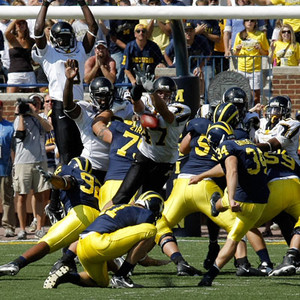
Google Images
The reason this particular game, despite being a non-conference match-up in the first week of college football, is number one is the ramifications of the game, the exciting nature and finish, and the monumental upset the Mountaineers pulled off against one of the nation’s winningest programs.
When Michigan offensive tackle Jake Long, quarterback Chad Henne and running back Mike Hart all decided to return for their senior seasons, along with head coach Lloyd Carr choosing not to retire, the Wolverines were favorites to win the Big Ten title and be a possible national title contender (they were ranked No. 5 in the AP poll going into the game).
Even though the Mountaineers were favorites to win a third straight FCS title and were building a dynasty of their own, entering the game boasting a 14-game winning streak, the game was expected to be such a blowout that some Las Vegas sportsbooks refused to offer a betting line. The Wolverines were 27-point favorites.
The Mountaineers exposed the weakness of the Wolverine secondary, tearing them up on passing yards to take a 28-17 lead at halftime. But the Wolverines stormed back to cut the lead to 31-26 after three quarters.
Late in the fourth after some exchanges in possession, Hart broke through the Mountaineers secondary and scored on a 54-yard run, giving the Wolverines their first lead of the game. However, for the second straight time, the Wolverines could not connect on the two-point conversion, and the held a 32-31 lead with just over four minutes remaining.
The Mountaineers quarterback Armanti Edwards led one final drive that covered seven plays and 69 yards to set up Mountaineers kicker Julian Rauch for a 24-yard field goal.
Rauch connected on the field goal to give the Mountaineers a 34-32 lead with 26 seconds remaining.
The Wolverines got the ball back and Henne connected with Wolverines receiver Mario Manningham for 46 yards, giving the Wolverines the ball on the Mountaineers’ 20 with six seconds left.
The Wolverines put the field goal unit on for the potential game-winner: a 37-yard field goal. However, for the second time, kicker Jason Gingell’s kick was blocked, this time by Corey Lynch, who ran the ball back all the way back to the Michigan five before being tackled as time expired. And 109,000+ at Michigan Stadium were stunned, jaws dropped and hands on their heads.
The Mountaineers put the David and Goliath story to rest, pulling off quite arguably the greatest upset in the history of college football, and fittingly landed number one on the top 10 greatest college football games of the 2000s.
Please leave a comment for feedback, and add a game you felt should have made the list. The thrill of victory and the agony of defeat. College football: where upsets happen.
Video: Appalachian State v. Michigan blocked field goal to end game
by Timothy Weisberg | Dec 17, 2010 | Blog
Eagles quarterback Michael Vick has expressed interest in owning another dog. His recent comments Thursday about bringing one into his house have generated new outrage.
ESPN’s Sportsnation even had a poll asking its audience whether or not he should be allowed to own a dog again. Really?
As a firm believer in second chances, Vick has paid dearly for his actions. The former Atlanta Falcons star lost everything as a result of the Bad Newz Kennels dog fighting case, including much of his property and was on the verge of filing for Chapter Nine.
He went from franchise player and multi-millionaire to convicted felon and nearly on his way to a bankruptcy court. But Vick served 21 months in prison, expressed remorse for his actions and was reinstated into the NFL by commissioner Roger Goodell.
So he used to have a dogfighting ring and practicing highly unethical behaviors towards the animals on his property. The only thing more you can do to the guy is make him wear a giant “F” on his chest for felon so the whole world knows what he did.
This isn’t The Scarlet Letter, and Michael Vick is not Hester Prynn.
Vick is actively working with the organization People for the Ethical Treatment of Animals (PETA), and has knowingly expressed guilt for his behavior.
I can bet my entire life savings of five dollars (the Tim Weisberg college fund needs some charitable donations) that if Michael Vick had a time machine (sponsored by Coke Zero of course), he would go back and change how the whole investigation unfoiled.
If anything people should respect and admire the incredible athlete who was out of the NFL for two years only to become quite arguably an even better player.
If anything, his time in jail was well spent, and helped a man who obviously made a monumental mistake that nearly cost him his career, life and all of his assets.
No equity, liquidity, you name it. The man lost everything.
People need to realize Vick has kids and isn’t a little boy anymore. The man is 30 years old, and if he expresses interest in owning a dog, more power to him for trying to put the past behind him.
After all, he is a human being just like the rest of us.
“I really mean what I say. I don’t have a problem. I’m not a psychopath. I’m not crazy. I’m a human being,” Vick told the Associated Press Thursday.
“What happened in my past and what I did in the culture I grew up in doesn’t shape and mole me as the person I am now. I said it before that I wish I can own a dog, and I’ll continue to say it…”
He is clearly remorseful for what he did, and while he may have forever tarnished his reputation as a role model, he is ultimately a human being and like the rest of us, makes mistakes.
He still has to wait another year and a half before he can own a dog.
It’s not like he is asking to own 100 pitbulls. He just wants a dog.
Telling him he can never own a dog again is like telling a man/woman who commits adultery he/she can never get married again.
There would be no lessons in life without second chances. This is Vick’s second chance, and he is rising to the occasion in a way nobody ever expected him to–as an athlete, public figure and above all, a parent.
After all, a dog is a man’s best friend.
by Timothy Weisberg | Dec 17, 2010 | Blog
The year is 1997 and I am seven years old, and its late in October, game seven of the 1997 World Series between the Florida Marlins and the Cleveland Indians. Being an innocent kid, I was rooting for the Marlins because that was my Little League team. I had begged my dad to let me stay up late to watch game seven go into extra innings, and Renteria steps to the plate.
What may go down as the greatest clutch hit in Marlins as well as World Series history, Renteria slapped a screamer up the middle out of the outstretched arm of the Indians’ second baseman, Craig Counsell came around to score and the rest is history.
Fast forward to the year 2010, and Renteria is now wearing a Giants uniform and the Giants are looking for a Giant play. It’s game five and Rangers ace Cliff Lee is pitching a gem with a 1-0 cushion. To make a long story short, Renteria hit a three-run blast off Lee and the Giants ended up winning the game and the series in part to his late-inning home run.
The Giants came off as no surprise when the declined Renteria’s $9.5 million-dollar option, as Renteria was nagged with injuries and only played in 74 games during the regular season, which included three stints on the disabled list.
The Giants offered the 2010 World Series MVP a measly one-year, $1 million dollar offer to return as a Giant and Renteria was offended and heated over the offer.
“That offer from the Giants was a lack of respect,” Renteria told ESPNDeportes.com Thursday from Colombia. “A total disrespect.”
But what may come off as more disrespectful is Renteria’s pride and arrogance. Sure he was the unsung hero in game five and batted over .400 en route to the Giants first world series since 1958, but Renteria and the rest of these athletes in the twilight of their careers need to realize that baseball is a business.
Baseball is a performance-based business, and your paycheck is correlated with your contributions to the team and your ability to perform. Renteria had made close to $20 million the previous two seasons, and played in less than half of the 2010 regular season, and his performance during the regular season the past few years has been anything but respectable.
Not to mention the $500,000 buyout he received when the Giants declined his contract, but Renteria has been living the high life for the majority of his career.
The unemployment rate is close to 10 percent in America and he is insulted by a one-million dollar offer. I idolized Renteria growing up, and he should be grateful he was even welcomed back.
If he feels more inclined to hang up his cleats, then the San Francisco Giants are better without him. He wasn’t the only player that helped the Giants win their first World Series since moving to San Francisco.
Ace Tin Lincecum, closer Brian Wilson, sluggers Pat Burrell and Cody Ross ring any bells?
The problem with athletes today is that they have an incredible sense of entitlement and whenever they achieve something great, they act upon that to increase their worth.
Renteria is 34 and on the decline. He showcased a memorable performance during the 2010 World Series.
But baseball is a business. But to Renteria, baseball means playing for money.
“To play for a million dollars, I’d rather stay with my private business and share more time with my family,” he later said.
Would you have that private business without baseball? Not likely.
Mr. Renteria, the door is right there. You had an incredible career and were one of the game’s best shortstops of my generation.
To play for a million dollars? I would do anything to play for a million dollars.
I would even do anything for a Klondike Bar.

